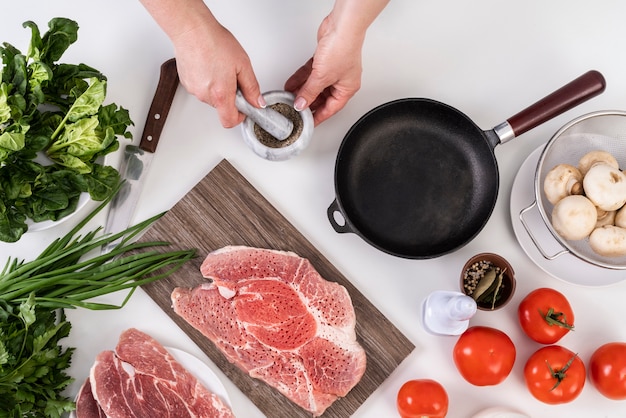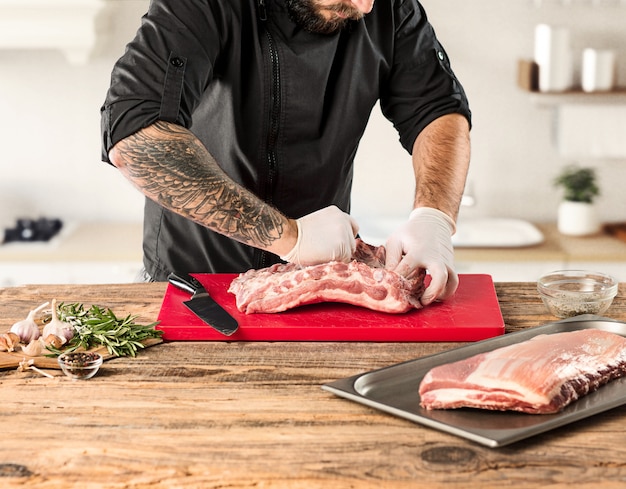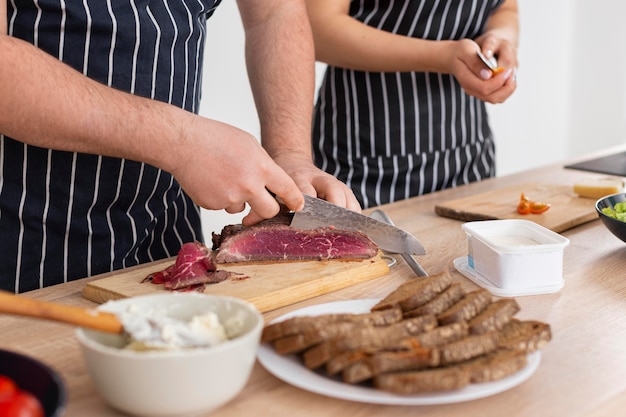I've been cooking for years, and nothing quite compares to a beautifully browned pork roast, a juicy pork chop, or a crispy crackling. It's truly a culinary delight. But let’s face it, there's also a bit of trepidation when it comes to cooking pork. We all know it needs to be cooked thoroughly, but what does that really mean? Well, fret no more! I'm here to help demystify the world of pork cooking temperatures, ensuring you're getting those delicious results without any nasty surprises.
Part 1: Navigating the World of pork safety

It's a universally accepted fact: pork needs to be cooked thoroughly to eliminate any lingering bacteria. But what exactly constitutes "thoroughly cooked?" That's where the UK Food Standards Agency (FSA) comes in with their handy guidelines. The rule of thumb? Pork should reach an internal temperature of 71°C (160°F). That's the absolute minimum, folks. I, for one, like to aim for a tad higher, just to be extra cautious and ensure the meat is perfectly tender and juicy.
Why is a Temperature Check Crucial?
Honestly, relying solely on visual cues isn’t enough. Pork can be a bit tricky – it might look cooked on the outside but still be raw in the middle. That’s why a good quality meat thermometer is your best friend. It's the only way to be certain the internal temperature has hit that magic 71°C mark.
How to Use a Meat Thermometer: A Quick Guide
Using a meat thermometer is a breeze. Just insert the probe into the thickest part of the meat, ensuring it's not touching any bone. Leave it in for a few seconds, and bam! You've got your accurate reading.
Beyond the Thermometer: What to Watch For
While the thermometer is your ultimate guide, there are some visual clues to look for. As the pork cooks, the colour will change from a pale pink to a more opaque white or grey. The juices will also run clear, rather than pink or bloody. Remember, these visual cues are supplementary to the thermometer, not substitutes.
Part 2: The Pork Pantry: A Tour of Different Cuts

Now that we've established the temperature, let's delve into the diverse world of pork cuts. Each cut has its unique characteristics and cooking methods, so choosing the right technique is crucial for optimal results. Let's explore some popular cuts and uncover their secrets to perfection.
Pork Roasts: The Star of Sunday Dinners
Pork roasts, oh how I adore them! They're the undisputed heroes of any Sunday roast, and they come in a variety of shapes and sizes. For a classic roast, consider a shoulder or loin – both are fantastic for slow roasting and deliver a succulent, flavorful result. If you're feeling a bit fancy, try a crown roast, which is a ring of ribs with the bones removed. It's a stunning presentation perfect for a special occasion.
roast pork: Secrets to Tenderness and a Crispy Crackling
To achieve a juicy, tender roast, keep these tips in mind:
- Season Generously: A generous rub of salt, pepper, and your favourite herbs will enhance the flavour significantly.
- Sear the Skin: This is essential for that glorious crispy crackling. Before roasting, heat a little oil in a pan and sear the skin until it starts to blister.
- Slow and Low is the Key: Cook your roast at a low temperature (around 150°C/300°F) for a longer time. This ensures even cooking and juicy, tender meat.
- Resting is a Must: Let the roast rest for 10-15 minutes before carving. This allows the juices to redistribute, resulting in a more succulent and flavorful roast.
pork chops: The Weeknight Hero
Pork chops are a quick and easy weeknight dinner solution. They come in various thicknesses, from thin and delicate to thick and juicy. I'm a fan of bone-in chops, as they tend to retain more moisture during cooking.
Pork Chops: Mastering Different cooking techniques
There are numerous ways to cook pork chops, each offering a unique flavour profile. Here are a few of my favourites:
- Pan-frying: Perfect for thin chops, sear them over high heat for a crispy crust.
- Grilling: For a smoky flavour, grill your chops over medium heat.
- Oven-baking: Bake chops in the oven for a juicy and tender result.
Bacon: The Breakfast Star and Beyond
Bacon! Need I say more? This salty and smoky treat is a breakfast staple and a perfect addition to sandwiches, salads, and even pasta dishes.
Bacon: Achieving that Perfect Crisp
While most people fry bacon, there are other methods for achieving that perfect crisp:
- Oven-baking: Lay your bacon on a baking sheet and bake in a preheated oven until crispy.
- Air-frying: For a healthier option, air fry your bacon until it reaches your desired level of crispness.
Sausages: Versatile and Delicious
pork sausages are incredibly versatile and come in all sorts of flavours, from classic pork and sage to spicy chorizo. They're a great addition to any meal, whether served as a main course or as part of a larger spread.
Sausages: Cooking Techniques for All Tastes
Whether you're grilling, pan-frying, or baking, just make sure you cook sausages through until they reach an internal temperature of 71°C (160°F).
Part 3: The Temperature Chart: A Guide for Different Pork Cuts

To make things even easier, here's a handy table that outlines the recommended internal temperatures for various cuts of pork:
| Pork Cut | Internal Temperature (°C) | Internal Temperature (°F) |
|---|---|---|
| Roast | 71 | 160 |
| Chops | 71 | 160 |
| Bacon | 71 | 160 |
| Sausages | 71 | 160 |
Part 4: Mastering the Art of Cooking Pork: From Basics to Beyond
Now that we've covered the essentials, let’s dive into some practical tips for cooking pork to perfection.
Slow and Low: The Secret to Tenderness
For pork roasts, the key is to cook it slow and low. This means cooking the meat at a low temperature (around 150°C/300°F) for a longer time. The low temperature allows the meat to cook evenly, resulting in a wonderfully tender roast.
Resting: A Must-Do for Juicy Results
After cooking, let your pork rest for 10-15 minutes before carving. This allows the juices to redistribute throughout the meat, leading to a more succulent and flavorful result.
Don't Overcook: A Common Mistake to Avoid
overcooked pork can be dry and tough. It's better to err on the side of slightly undercooked, as you can always cook it a little longer if needed.
Part 5: Beyond the Basics: Elevating Your Pork Dishes with Marinades and Rubs
Let's spice things up! Marinades and rubs can elevate your pork dishes to new heights. A good marinade will add moisture and flavour, while a rub creates a delicious crust.
Marinade Magic: A Symphony of Flavors
A marinade can be as simple or as complex as you like. Try using a combination of acidic ingredients like lemon juice or vinegar, oil, and your favourite herbs and spices. Some popular marinade combinations include:
- Citrus and Herb: Lemon juice, olive oil, rosemary, and thyme create a bright and aromatic marinade.
- Honey Garlic: Honey, soy sauce, garlic, and ginger create a sweet and savory marinade.
- Spicy Chipotle: Chipotle peppers in adobo sauce, lime juice, and cumin create a smoky and spicy marinade.
Rub it In: Creating Delicious Crusts
Rubs are a fantastic way to add flavour and create a crispy crust on your pork. A simple salt and pepper rub is always a winner, but feel free to get creative with other herbs and spices. Here are a few ideas:
- Herby: Combine dried herbs like rosemary, thyme, oregano, and sage with salt and pepper.
- Spicy: Mix paprika, cayenne pepper, garlic powder, and onion powder for a kick of heat.
- Sweet and Smoky: Combine brown sugar, smoked paprika, garlic powder, and onion powder for a sweet and smoky flavour.
Part 6: Pork Pairings: The Perfect Accompaniments
Pork is a versatile protein that pairs beautifully with a range of side dishes. Here are some of my favourites:
Apple Sauce: A Classic Choice
Apple sauce is a timeless classic that complements pork perfectly. Its sweetness and tartness cut through the richness of the meat.
Roasted Vegetables: A Burst of Colour and Flavour
Roasted vegetables are a great way to add colour, texture, and flavour to your pork dish. Try roasting root vegetables like carrots, parsnips, and potatoes, or opt for something more vibrant like Brussels sprouts or asparagus.
mashed potatoes: Comforting and Delicious
Mashed potatoes are a comforting and delicious accompaniment to pork. They’re easy to make and always a crowd-pleaser.
Gravy: The Perfect Finishing Touch
A good gravy elevates any pork dish to the next level. It adds richness and moisture, and it's a fantastic way to soak up all those delicious juices.
Other Delicious Pairings:
- Slaw: A crunchy and tangy slaw adds a refreshing contrast to rich pork dishes.
- Rice: A simple side of rice provides a neutral base for flavorful pork dishes.
- Polenta: Creamy polenta adds a comforting and satisfying element to the plate.
- fruit salad: A bright and refreshing fruit salad offers a delightful contrast to savory pork dishes.
Part 7: Pork Leftovers: Don't Waste a Bite!
Leftover pork is a culinary treasure. Don’t let it go to waste! Here are some ideas for transforming those leftovers into delicious meals:
Pork Sandwiches: Quick and Easy
Shred leftover pork and make delicious sandwiches. Top them with your favourite sauces and condiments like bbq sauce, mustard, mayonnaise, or pickles.
Pork Soup: A Warm and Hearty Meal
Turn leftover pork into a comforting and hearty soup. Add vegetables, broth, and seasonings like carrots, celery, onions, garlic, and your choice of herbs to create a flavorful meal.
Pork Stir-fry: A Quick and Flavorful Dinner
Slice leftover pork and add it to a stir-fry with your favourite vegetables and sauce. This is a quick and easy way to use up leftovers and create a delicious and satisfying meal.
Pork Pasta: A Hearty and Delicious Pasta Dish
Use leftover pork to make a hearty and delicious pasta dish. Sauté the pork with garlic and onion, then add your favourite pasta sauce and cooked pasta.
Pork Hash: A Savory and Hearty Breakfast
Dice leftover pork and combine it with potatoes, onions, and peppers for a savory and hearty breakfast hash.
Part 8: FAQs: Addressing Common Pork Cooking Questions
Let’s tackle some frequently asked questions about pork cooking:
1. What's the Difference Between Cooking Pork and Other Meats?
Pork is a bit more delicate than some other meats, like beef or chicken. It's important to ensure it's cooked thoroughly to eliminate any bacteria. With other meats, you may have more flexibility in terms of doneness.
2. Can I Cook Pork to a Higher Temperature Than 71°C (160°F)?
Absolutely! While 71°C (160°F) is the minimum safe temperature, cooking pork to a higher temperature, like 75°C (165°F), is perfectly fine and will result in even more tender meat.
3. What Should I Do If I Think I've Undercooked Pork?
If you're unsure whether pork is cooked through, it's best to err on the side of caution and cook it further. Don't risk food poisoning! You can always cook it a bit longer in the oven or pan.
4. How Can I Tell If Pork is Cooked Through?
The best way to tell if pork is cooked through is to use a meat thermometer. Insert the probe into the thickest part of the meat, making sure it's not touching any bone. Cook until the internal temperature reaches 71°C (160°F).
5. What Are Some Signs That Pork Has Gone Bad?
Pork that has gone bad will have a sour smell and an off colour. It may also feel slimy to the touch. If you notice any of these signs, it’s best to throw the pork away.
6. How Long Can I Keep Leftover Pork in the Fridge?
Leftover pork can be stored in the refrigerator for 3-4 days. Make sure to store it properly in an airtight container to prevent any cross-contamination.
Part 9: Embracing the Joy of Pork Cooking: A culinary adventure Awaits
Cooking pork is a rewarding experience, offering countless opportunities to experiment and create delicious dishes. Remember, safety should always come first, but don't be afraid to explore different techniques and flavours. Armed with the right knowledge and a touch of culinary confidence, you'll be able to create pork dishes that are both delicious and safe. Happy cooking!
Everyone is watching

Prime Rib Roast Cooking Time Chart: Per Pound Guide
Cooking TipsPrime rib roast. Just the name conjures images of lavish dinners, crackling fires, and hearty laughter. It’s ...

How Long to Bake Potatoes in the Oven (Perfect Every Time)
Cooking TipsBaked potatoes are a staple in my kitchen. They're incredibly versatile, delicious, and surprisingly easy to m...

Perfect Rice Every Time: The Ultimate Guide to Cooking Rice
Cooking TipsAs a self-proclaimed foodie, I've always been a bit obsessed with rice. It's the foundation of countless cuisi...

The Ultimate Guide to Cooking Asparagus: Tips, Techniques, and Recipes
Cooking TipsAsparagus. The mere mention of this spring delicacy conjures up images of vibrant green spears, crisp and burs...

Ultimate Guide to Cooking the Perfect Thanksgiving Turkey
Cooking TipsThanksgiving. Just the word conjures up images of overflowing tables laden with delicious food, the scent of r...
